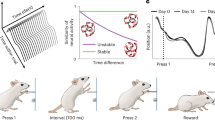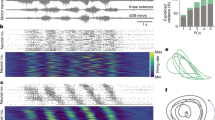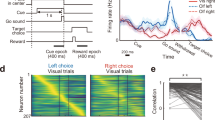Abstract
When an animal learns to make movements in response to different stimuli, changes in activity in the motor cortex seem to accompany and underlie this learning1,2,3,4,5,6. The precise nature of modifications in cortical motor areas during the initial stages of motor learning, however, is largely unknown. Here we address this issue by chronically recording from neuronal ensembles located in the rat motor cortex, throughout the period required for rats to learn a reaction-time task. Motor learning was demonstrated by a decrease in the variance of the rats' reaction times and an increase in the time the animals were able to wait for a trigger stimulus. These behavioural changes were correlated with a significant increase in our ability to predict the correct or incorrect outcome of single trials based on three measures of neuronal ensemble activity: average firing rate, temporal patterns of firing, and correlated firing. This increase in prediction indicates that an association between sensory cues and movement emerged in the motor cortex as the task was learned. Such modifications in cortical ensemble activity may be critical for the initial learning of motor tasks.
This is a preview of subscription content, access via your institution
Access options
Subscription info for Japanese customers
We have a dedicated website for our Japanese customers. Please go to natureasia.com to subscribe to this journal.
Buy this article
- Purchase on SpringerLink
- Instant access to full article PDF
Prices may be subject to local taxes which are calculated during checkout




Similar content being viewed by others
References
Mitz, A. R., Godschalk, M. & Wise, S. P. Learning-dependent neuronal activity in the premotor cortex: activity during the acquisition of conditional motor associations. J. Neurosci. 11, 1855– 1872 (1991).
Germain, L. & Lamarre, Y. Neuronal activity in the motor and premotor cortices before and after learning the associations between auditory stimuli and motor responses. Brain Res. 611, 175–179 (1993).
Chen, L. L. & Wise, S. P. Neuronal activity in the supplementary eye field during acquisition of conditional oculomotor associations. J. Neurophysiol. 73, 1101–1121 (1995).
Chen, L. L. & Wise, S. P. Supplementary eye field contrasted with the frontal eye field during acquisition of conditional oculomotor associations. J. Neurosci. 73, 1122– 1134 (1995).
Chen, L. L. & Wise, S. P. Evolution of directional preferences in the supplementary field acquisition of conditional oculomotor associations. J. Neurosci. 16, 3067– 3081 (1996).
Chen, L. L. & Wise, S. P. Conditional oculomotor learning: population vectors in the supplementary eye field. J. Neurophysiol. 78, 1166–1169 ( 1997).
Georgopoulos, A. P. et al. Primate motor cortex and free arm movements to visual targets in three-dimensional space. II. coding of the direction of movement by a neuronal population. J. Neurosci. 8, 2928– 2938 (1988).
Shadlen, M. N & Newsome, W. T. Noise, neural code and cortical organization, Curr. Opin. Neurobiol. 4, 569–579 (1994).
Murthy, V. N. & Fetz, E. E. Coherent 25- to 35-Hz oscillations in the sensorimotor cortex of awake behaving monkeys. Proc. Natl Acad. Sci.USA. 89, 5670–5674 (1992).
Nicolelis, M. A. L. et al. Sensorimotor encoding by synchronous neural ensemble activity at multiple levels of the somatosensory system. Science 268, 1353–1358 (1995).
Donoghue, J. P. et al. Neural discharge and local field potential oscillations in primate motor cortex during voluntary movements. J. Neurophysiol. 79, 159–173 ( 1998).
Seidemann, E. et al. Simultaneously recorded single units in the frontal cortex go through sequences of discrete and stable states in monkeys performing a delayed localization task. J. Neurosci. 16, 752–768 (1996).
Riehle, A. et al. Spike synchronization and rate modulation differentially involved in motor cortical function. Science 278, 1950–1953 (1997).
Hatsopoulos, N. G. et al. Information about movement direction obtained from synchronous activity of motor cortical neurons. Proc. Natl Acad. Sci. USA 95, 15706–15711 (1998).
Maynard, E. M. et al. Neuronal interactions improve cortical population coding of movement direction. J. Neurosci. 19, 8083 –8093 (1999).
Almaric, M. & Koob, G. F. Depletion of dopamine in the caudate nucleus but not in the nucleus accumbens impairs reaction time performance in rats. J. Neurosci. 7, 2129– 2134 (1987).
Kohonen, T. Self-organizing Maps (Springer, New York, 1997).
Nicolelis, M. A. L., Stambaugh, C. R., Brisben, A. & Laubach, M. in Methods for Simultaneous Multisite Neural Ensemble Recordings in Behaving Primates (ed. Nicolelis, M. A. L.) 121–156 (CRC, Boca Raton, 1999).
Krippendorff, K. Information Theory: Structural Models for Qualitative Data (Sage, Thousand Oaks, California, 1986)
Efron, B. & Tibshirani, R. An Introduction to the Bootstrap. (Chapman & Hall, New York, 1994).
Lee, T. W., Girolami, M. & Sejnowski, T. J. Independent component analysis using an extended infomax algorithm for mixed subgaussian and supergaussian sources. Neural Comput. 11, 417–441 (1999).
Laubach, M., Shuler, M. & Nicolelis, M. A. L. Independent component analyses for quantifying neuronal ensemble interactions. J. Neurosci. Meth. 94, 141–154 (1999).
Nicolelis, M. A. L. et al. Reconstructing the engram: simultaneous, multiple site, many single neuron recordings. Neuron 18, 529 –537 (1997).
Loeb, G. E. & Gans, C. Electromyography for Experimentalists (Univ. of Chicago Press, Chicago, 1986).
Nicolelis, M. A. L. et al. Simultaneous encoding of tactile information by three primate cortical areas. Nature Neurosci. 1, 621– 630 (1998).
Ghazanfar, A. A., Stambaugh, C. R. & Nicolelis, M. A. L. Multiple strategies for encoding tactile information by somatosensory thalamocortical ensembles. J. Neurosci. (in the press).
Mosteller, F. & Tukey, J. W. Data Analysis and Regression: A Second Course in Statistics (Addison-Wesley, Reading, Massachusetts, 1977).
Buckheit, J. & Donoho, D. Improved linear discrimination using time-frequency dictionaries. Proc. SPIE 2569, 540–551 (1995).
Reyment, R. A. & Jöreskog, K. G. Applied Factor Analysis in the Natural Sciences (Cambridge Univ. Press, New York, 1993).
Acknowledgements
We thank P. Beck, D. Cohen, D. Katz, D. Krupa, M. Shuler and B. Storey-Laubach for comments on the manuscript. The work was supported by grants from the National Institute of Health (M.L. and M.A.L.N.), the National Science Foundation, the Defense Advanced Research Project Agency, the Office of Naval Research, and the Human Frontiers and Whitehall Foundations (M.A.L.N.). J.W. was supported by the Swedish Foundation for International Cooperation in Research and Higher Education and by the Swedish Medical Research Council.
Author information
Authors and Affiliations
Corresponding author
Rights and permissions
About this article
Cite this article
Laubach, M., Wessberg, J. & Nicolelis, M. Cortical ensemble activity increasingly predicts behaviour outcomes during learning of a motor task. Nature 405, 567–571 (2000). https://doi.org/10.1038/35014604
Received:
Accepted:
Issue Date:
DOI: https://doi.org/10.1038/35014604



